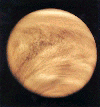Down
| 1. | A straight line through the center of a circle, from one side to another. |
| 2. | A relatively small, icy celestial body with a long tail of light that revolves around the sun. |
| 3. | The smallest planet in the Solar System. |
| 4. | Saturn has two of these that are very bright. |
| 5. | A very large group of stars and planets that includes the Sun and its solar system. (3 words - include spaces in puzzle) |
| 6. | In Roman mythology, this planet is named after the god of war. |
| 7. | A force that pulls objects toward another object. On Earth, this force pulls things to the ground. |
| 8. | The curved path in which a planet, satellite, or spacecraft revolves around another body. |
| 9. | One complete circular movement made by one object around another object. |
| 10. | That point of a planet's or comet's orbit which is most distant from the sun. |
| 11. | A piece of rock or metal from space that enters the earth's atmosphere at high speed and burns up. |
| 12. | The nine major celestial bodies that orbits the sun. |
|
|
Across
| 5. | Any planet's natural satellite. |
| 13. | The degree of heat or cold of a body or an environment. |
| 14. | The largest planet in the Solar System. |
| 15. | The use of mathematics facilitated the discovery of this planet. |
| 16. | The amount of physical matter that an object contains, usually measured in grams or ounces. |
| 17. | The act of turning on, or around, an axis. On Earth, this is equal to 23 hours, 56 minutes, and 4 seconds. |
| 18. | This planet has two bright prominent rings. |
| 19. | A concentration of small celestial bodies between Mars and Jupiter. (2 words - include space in puzzle) |
| 20. | The mixture of gases that surrounds a planet. |
| 21. | The fastest moving planet in the Solar System. |
| 22. | Any of thousands of celestial bodies with diameters between one and five hundred miles that revolve around the sun in orbits located mostly between those of Jupiter and Mars. |
| 23. | In Roman mythology, this planet is named after the goddess of love and beauty. |
|









































































































































































































































































































































































































































































































































































































































